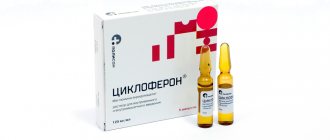Flemoxin solutab 125 mg n20 dispersible tablets
Latin name
Flemoxin Solutab
Active ingredient: Amoxicillin (Amoxicillin)
Compound
The composition of dispersible (water-soluble) tablets includes amoxicillin in the form of amoxicillin trihydrate, microcrystalline and dispersible cellulose, vanillin, crospovidone, flavors (lemon and tangerine), magnesium stearate, saccharin.
Release form
Flemoxin Solutab dispersible tablets:
125, 250, 500 or 1000 mg package No. 20 (blisters of 5 pcs., 4 blisters per package);
125 mg package No. 14 (blisters of 7 pcs., 2 blisters per package).
The tablets are oval, white or white with a yellowish tint, with a dividing line on one side, and a digital designation (231, 232, 234 and 236) and the manufacturer’s logo on the other.
pharmachologic effect
Antibacterial, bactericidal.
Pharmacodynamics and pharmacokinetics
Amoxicillin is a semisynthetic β-lactam antibiotic of the penicillin group with a wide spectrum of antimicrobial activity.
The bactericidal properties of the drug are due to the ability to suppress transpeptidase, disrupt the production of peptidoglycan (supporting protein of cell walls) during periods of division and growth, and provoke the lysis of microorganisms.
Shows activity against Gram (+) aerobes, including Staphylococcus spp. (with the exception of penicillinase-producing strains) and Streptococcus spp. (including Str.pneumoniae and faecalis); Gram (-) aerobes (gonococci, meningococci, Escherichia coli and Haemophilus influenzae, Proteus mirabilis; certain strains of Klebsiella, Shigella and Salmonella, as well as against H. pylori.
Ineffective against strains of Proteus P. rettgeri and vulgaris (they are indole-positive), serrations, pseudomonads, enterobacteria, Morganella morgani. Mycoplasma, rickettsia and viruses are resistant to amoxicillin.
A feature of the dosage form is that the tablets are easily dispersed in water to form a dispersion. Thanks to this, the drug is quickly and as completely as possible (more than 93% of the dose taken) absorbed from the digestive canal.
Eating does not affect the absorption of the substance. TCmax - ranging from 60 to 120 minutes. When taking dispersible tablets, the plasma concentration of amoxicillin is higher than when taking insoluble forms of the drug. The active substance is resistant to acids.
TCmax when taking 500 mg amoxicillin is 120 minutes. When taking twice as much or half as much of the drug, Cmax also changes by half.
About 20% of the administered amoxicillin dose is bound to plasma proteins. The substance in therapeutically effective concentrations penetrates well into bone tissue, mucous membranes, sputum and intraocular fluid. Its concentration in bile is 2-4 times higher than plasma concentration, in amniotic fluid - from 25 to 30% of plasma concentration in the body of a pregnant woman.
Amoxicillin passes through the BBB poorly, but in case of inflammation of the meninges, its concentration in the cerebrospinal fluid is about 1/5 of the plasma concentration.
The substance is partially metabolized; most metabolic products are inactive against pathogenic microflora.
Excretion is carried out by the kidneys. In patients with healthy kidneys, T1/2 - from 60 to 90 minutes, in children under six months of age (including premature babies and newborns) - from 3 to 4 hours. If liver function is impaired, the indicator does not change; if kidney function is impaired, it can increase to 8.5 hours (this is T1/2 of amoxicillin for anuria).
Indications for use
- bacterial infections of the external respiratory system (angina, pneumonia, bronchitis, pharyngitis, sinusitis, acute inflammation of the middle ear), genitourinary system (pyelonephritis, pyelitis, cystitis, urethritis, cervicitis, endometritis), skin and/or soft tissues (impetigo, erysipelas, secondary infected dermatoses), digestive system organs and abdominal infections (angiocholitis, peritonitis, typhoid fever, cholecystitis, salmonellosis, dysentery, salmonella carriage), if they are caused by bacteria sensitive to Flemoxin.
Flemoxin - what is it used for in pediatrics?
Flemoxin Solutab is the drug of the penicillin group most commonly used in pediatric practice. Most often it is prescribed for bacterial infections of the respiratory system.
Practical experience proves the high effectiveness of Flemoxin for sinusitis, acute non-purulent otitis, bronchitis, bronchopneumonia, tonsillitis, and sore throat.
The drug is safe, well tolerated by young patients of any age and, just as important when it comes to treating children, has excellent organoleptic properties.
Contraindications
Flemoxin is not prescribed for hypersensitivity to amoxicillin, other β-lactams or auxiliary components of the tablets.
Relative contraindications for the antibiotic Flemoxin Solutab:
lymphocytic leukemia;
Infectious mononucleosis;
renal failure;
history of gastrointestinal pathology (especially colitis associated with the use of antibiotics);
pregnancy;
lactation;
breastfeeding period;
polyvalent hypersensitivity to chemicals foreign to the body (xenobiotics).
Side effects
Side effects appear as:
nausea, changes in taste, diarrhea, vomiting, moderate increases in liver enzyme activity (sometimes), hemorrhagic and pseudomembranous colitis (extremely rare);
interstitial nephritis (extremely rare);
hemolytic anemia, neutropenia, agranulocytosis, thrombocytopenia.
When using the drug in the form of dispersible tablets, no adverse effects from the nervous system were observed.
The use of the drug may be accompanied by the development of hypersensitivity reactions, which are expressed in the form of a rash (mainly specific maculopapular), exudative erythema multiforme (rarely), angioedema and anaphylactic shock (in exceptional cases).
Instructions for use
How should adults take Flemoxin tablets?
The drug is taken orally, without reference to the time of meal.
The tablet can be dissolved in 20 ml of water to obtain a syrup or in 100 ml of water to obtain a suspension; it can be swallowed whole or taken in crushed form.
For mild and moderately severe infections, 250 mg tablets are taken in 2-3 pieces. 2 times a day, 500 mg tablets - 1-1.5 pcs. 2 r./day, 1000 mg tablets - half 3 r./day.
When treating severe diseases, as well as infections with hard-to-reach foci, it is preferable to take the drug three times a day.
The daily dose of antibiotic for severe infections, relapses and chronic pathologies is 1.5-2 tablets. 500 mg 3 times/day.
For acute gonorrhea without complications, a single dose of Flemoxin with Probenecid is indicated (dose, 3 and 1 g, respectively).
For severe infections and chronic pathologies, the treatment regimen is selected taking into account the characteristics of the clinical picture of the disease.
In case of kidney damage, in which the Clcr value is in the range from 15 to 40 ml/min, the interval between tablet doses should be increased to 12 hours. If Clcr does not exceed 10 ml/min, the dosage of amoxicillin should be reduced by 15-50%. For anuria, the highest daily dose of amoxicillin is 2 g.
How should children take Flemoxin tablets?
Children's Flemoxin is a tablet with a dosage of amoxicillin of 125 and 250 mg. The instructions for children indicate that it is more convenient for a younger child to give a syrup or suspension; older children can swallow the tablet whole or after chewing it.
Instructions for use
Flemoxin for children over 10 years of age is similar to the instructions for adults: for mild and moderately severe infections, the child is given 3-4 tablets. 125 mg 3 times/day.
Flemoxin Solutab for children over 3 years of age is prescribed to take 3 tablets. 125 mg 2 times/day. or 2 tablets. 125 mg 3 times/day.
For children under 3 years of age, according to the instructions for use, Flemoxin Solutab 125 mg, two tablets given 2 times a day. or one 3 rubles/day.
The dosage of Flemoxin Solutab for children, which contains 250 mg of amoxicillin, is as follows:
2-3 tab. 2 rubles/day — patients over 10 years of age;
1 tab. 3 rubles/day — patients 3-10 years old;
1 tab. 2 rubles/day or 0.5 tab. 3 rubles/day - patients under three years of age.
The daily dose of Flemoxin Solutab for children of all age groups (including children of the first year of life) is from 30 to 60 mg/kg, divided into 2 or 3 doses. If the disease is severe or the pathological focus is difficult to reach, it is preferable to take the drug 3 times a day.
For severe infections (including those with hard-to-reach lesions), the recommended dose of antibiotic is 60 mg/kg/day, divided into three doses.
Duration of treatment
The duration of the course for mild and moderately severe infections is from 5 days to 1 week. If the causative agent of the infection is Str. pyogenes, treatment lasts at least 10 days.
For severe infections, medication should be continued for 48 hours after symptoms disappear.
Antibiotic Flemoxin Solutab for sore throat
Sore throat is a common acute infectious disease, the local manifestations of which are damage to the tonsils (mainly the first and second tonsils). The most common causative agents of sore throat are B-hemolytic streptococci of group A. Staphylococci provoke it much less often.
Untreated or undertreated tonsillitis is complicated by paratonsillitis, nephritis, myocarditis, paratonsillar abscess, and tonsillogenic sepsis.
Given the bacterial nature of the disease, timely use of antibiotics is very important. If in case of catarrhal tonsillitis, in some cases, local antibiotics are enough for the patient, then in case of follicular and lacunar tonsillitis, the doctor must prescribe systemic drugs.
Research results and practical experience have shown that the most effective remedies for angina are drugs of the penicillin group.
The advantages of Flemoxin over analogues are:
unique dosage form (Solyutab);
the presence of tablets with a “children’s” dosage of the active substance;
the possibility of using the drug without being tied to the time of meals.
For adults with sore throat, it is recommended to take the drug 2 times a day. 500-700 mg each. For angina in children, children's Flemoxin Solutab is used - tablets with a minimum dosage of the active substance. The dose is selected by the doctor depending on the patient’s age and the characteristics of the disease.
After the symptoms of sore throat are relieved (body temperature decreases, pustules on the tonsils disappear, sore throat goes away, the condition of the lymph nodes normalizes), taking Flemoxin should be continued for at least two more days.
If treatment is stopped immediately, the risk of disease recurrence is high. Moreover, the symptoms may appear with a vengeance.
Use of the drug for sinusitis
Sinusitis is an inflammation of the paranasal sinuses.
The use of an antibiotic for sinusitis is advisable if the disease is caused by bacteria sensitive to its action. When associated with a viral or fungal infection, as well as allergic sinusitis, antibiotic therapy is not only ineffective, but can also aggravate the course of the disease.
Acute bacterial sinusitis manifests itself first:
hyperthermia (febrile temperature or higher);
violation of nasal respiration and phonation;
soreness and swelling of the skin in the projection of the maxillary cavities;
decreased sense of smell;
the presence of pain radiating to different parts of the face (the pain gradually loses its specific location);
symptoms of general intoxication (sleep disturbances, headache, joint pain, etc.);
the characteristic color of the pathological secretion discharged from the sinuses (its color in bacterial infections usually varies from yellow to dark green).
The selection of an antibiotic is carried out taking into account:
the results of a microbiological study of biomaterial taken from the paranasal sinuses and a rapid test for staining of the pathogen using the Gram method;
characteristics of the patient’s body;
possible allergic reactions to the drug;
presence of concomitant diseases.
If the cause of the disease is staphylococci, streptococci or Haemophilus influenzae, it is considered most preferable to prescribe drugs of the penicillin group to the patient.
The use of amoxicillin for bacterial sinusitis (including complicated forms of the disease) gives a pronounced positive effect already in the first 7 days of treatment: the patient’s symptoms of intoxication and pain in the paranasal sinuses decrease/disappear, the temperature decreases and nasal breathing becomes easier.
The effectiveness of Flemoxin Solutab is explained by the fact that this drug:
affects a large number of strains of infectious agents;
quickly and in high concentrations absorbed from the digestive tract;
resistant to gastric juice;
Available in an easy-to-use form.
Overdose
Symptoms
overdose of Flemoxin Solutab: nausea, diarrhea, vomiting, water-salt imbalance.
Treatment:
gastric lavage, prescribing enterosorbents, saline laxatives, taking measures aimed at correcting the balance of water and electrolytes.
Interaction
Phenylbutazone, probenecid, oxyphenbutazone and, to a slightly lesser extent, sulfinpyrazone and ASA inhibit the secretion of penicillin antibiotics, which leads to an increase in T1/2 and an increase in the plasma concentration of amoxicillin.
Bactericidal antibiotics (including rifampicin, vancomycin, cephalosporins and aminoglycosides) have a synergistic effect when used in combination with Flemoxin.
When taken simultaneously with certain bacteriostatic agents (sulfonamides, chloramphenicol, etc.), antagonism is possible.
Use with estrogen-containing oral contraceptives may reduce the effectiveness of the latter and increase the risk of recurrent bleeding.
Use in combination with allopurine, unlike the combination of Ampicillin with allopurine, does not increase the frequency of skin reactions.
Terms of sale
On prescription.
Storage conditions
Store at temperatures below 25°C.
Best before date
Five years.
Flemoxin Solutab®
Hypersensitivity reactions
Before starting treatment with amoxicillin, you should pay attention to the presence of hypersensitivity reactions to penicillins, cephalosporins or other beta-lactam antibiotics in the anamnesis (see sections “Contraindications” and “Side effects”).
Severe and sometimes fatal hypersensitivity reactions (including anaphylactic reactions and severe skin reactions) have been reported in patients receiving penicillin therapy. The development of these reactions is more likely in people with a history of hypersensitivity to penicillins and in people with atopy. If an allergic reaction occurs, discontinue treatment with amoxicillin and institute appropriate alternative treatment.
Acute coronary syndrome associated with hypersensitivity (Kounis syndrome)
In rare cases, hypersensitivity reactions (acute coronary syndrome associated with hypersensitivity) have been reported during treatment with amoxicillin. If this reaction occurs, amoxicillin should be discontinued and appropriate treatment should be prescribed.
Insensitive microorganisms
For some types of infections, before prescribing amoxicillin, it is necessary to first establish the pathogen and its sensitivity to the drug, or make sure that the pathogen is likely to be treatable with amoxicillin. This particularly applies to patients with urinary tract infections and severe ear, nose and throat infections.
Convulsions
Convulsions may occur in patients with renal failure, in patients receiving high doses of the drug, as well as in patients with predisposing factors - a history of seizures, treatment for epilepsy or meningitis, etc. (see section “Side Effects”).
Kidney failure
In patients with renal insufficiency, the dose should be adjusted according to the degree of renal insufficiency (see section "Dosage and Administration").
Skin reactions
The occurrence of generalized erythema with fever, accompanied by pustules, at the initial stage of treatment may be a symptom of OHEP (see section “Side effects”). In this case, amoxicillin should be discontinued, and its subsequent use will be contraindicated in any situation.
The use of amoxicillin should be avoided in patients who are suspected of having infectious mononucleosis, since a measles-like rash (exanthema) may occur due to the use of amoxicillin for this disease.
Jarisch-Herxheimer reaction
The Jarisch-Herxheimer reaction has been observed following the use of amoxicillin in patients with Lyme disease. This reaction is associated with the bactericidal effect of amoxicillin on the causative agent of Lyme disease, the spirochete Borrelia burgdorferi. Patients should be advised that this reaction is a common side effect of antibiotic treatment for Lyme disease and usually goes away on its own.
Excessive growth of non-susceptible microorganisms
Long-term use of the drug can sometimes lead to excessive growth of microorganisms that are not sensitive to amoxicillin (superinfection).
When using almost all antibacterial drugs, the development of colitis associated with taking antibiotics is possible. Its severity can range from mild to severe (life-threatening). Therefore, it is important to consider the possibility of this diagnosis in patients who develop diarrhea during or after antibiotic use. If diarrhea develops, the patient should immediately stop taking amoxicillin, consult a doctor and begin appropriate treatment. Medicines that inhibit peristalsis are contraindicated in this situation.
Long-term treatment
During long-term therapy, it is necessary to periodically monitor the function of the hematopoietic organs, kidneys and liver. Increased activity of liver enzymes and changes in the number of blood cells were reported.
Anticoagulants
Rare cases of increased prothrombin time have been reported in patients receiving amoxicillin. When prescribing the drug simultaneously with anticoagulants, appropriate monitoring should be carried out, and the dose of oral anticoagulants may need to be adjusted to maintain the required level of blood clotting (see sections “Interaction with other drugs” and “Side effects”).
Crystalluria
In patients with reduced diuresis, crystalluria was very rarely observed, mainly during parenteral therapy. When using high doses of amoxicillin, it is recommended to maintain adequate fluid intake and diuresis to reduce the likelihood of developing crystalluria associated with amoxicillin use. In patients with a catheterized bladder, catheter patency should be checked regularly.
Impact on diagnostic tests
Increased levels of amoxicillin in serum and urine may interfere with some laboratory tests. Due to high concentrations of amoxicillin in urine, chemical methods often give false-positive results.
When determining glucose in urine during treatment with amoxicillin, it is recommended to use enzymatic glucose oxidase tests.
The use of amoxicillin may affect the results of the quantitative determination of estradiol in urine in pregnant women.



